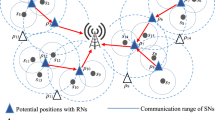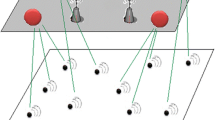Abstract
Relay node deployment in wireless sensor network (WSN) is significantly explored in specialized literature. There is a wide spectrum of performance issues like connectivity, coverage, energy efficiency, latency of packet delivery that have been considered as the target criteria to be optimized with the deployment strategies of relay nodes. The dynamic variation of different attributes of the sensor nodes leverages a heterogeneous topology. None of the literature has considered a heterogeneity-aware relay node placement strategy to pacify the effect of structural diversity on network performance. In this work, we propose chaos genetic algorithm-based relay node placement (CGARP) which takes care of the structural heterogeneity of WSN. CGARP is based on chaos genetic algorithm (CGA), which overcomes the problem of premature convergence of genetic algorithm. Tent Map-based generation of the initial population and Logistic Map-based chaotic crossover enable CGARP to work well in WSN. The proposed technique has been compared with other relay node placement solutions available in the literature. CGARP achieves 68% improvement in average network lifetime in a 2D grid. It also results in 27% better connectivity and 23% improvement in the usage of relay nodes compared to EERP. The results are obtained through properly designed experiments with simulated realistic environments. These results substantiate the improvements achieved by the proposed approach.











Similar content being viewed by others
Availability of data and material
Data sharing is not applicable to this article as no datasets were generated or analyzed during the current study. All the data are generated based on the simulation of different parameters with theoretical constraints.
Code availability
The working environment for the current study has been designed in MATLAB by the authors. The codes are available with the corresponding author and can be shared with the respected Editors and Reviewers as and when required.
References
Akyildiz IF, Su W, Sankarasubramaniam Y, Cayirci E (2002) Wireless sensor networks: a survey. Comput Netw 38:393–422
Vieira MAM, Coelho CN, Da Silva DC, da Mata JM (2003) Survey on wireless sensor network devices. In: Proceedings of IEEE Conference on Emerging Technology Fact. Autom., ETFA03, pp 537–544
Mohemed RE, Saleh AI, Abdelrazzak M, Samra AS (2017) Energy-efficient routing protocols for solving energy hole problem in wireless sensor networks. Comput Netw 114:51–66
Chang J-H et al (2011) An efficient relay sensor placing algorithm for connectivity in wireless sensor networks. J Inf Sci Eng 27(1):381–392
Djenouri D, Bagaa M (2017) Energy-aware constrained relay node deployment for sustainable wireless sensor networks. IEEE Trans Sustain Comput 2(1):30–42
Ayinde BO, Barnawi AY (2014) Differential evolution based deployment of wireless sensor networks. In: 2014 IEEE/ACS 11th International Conference on Computer Systems and Applications (AICCSA). IEEE
Hashim HA, Bo A, Abido MA (2016) Optimal placement of relay nodes in wireless sensor network using artificial bee colony algorithm. J Netw Comput Appl 64:239–248
Ayinde BO, Hashim HA (2018) Energy-efficient deployment of relay nodes in wireless sensor networks using evolutionary techniques. Int J Wireless Inf Networks 25(2):157–172
Xu H, Huang L, Gang W, Zhang Y (2009) Spanner-aware relay node placement in wireless ad hoc sensor networks. In: Proceedings of the 5th International Conference on Mobile Ad-hoc and Sensor Networks (MSN), pp 180–186. https://doi.org/10.1109/MSN.2009.14.
Han B, Li J, Su J (2013) Optimal relay node placement for multi-pair cooperative communication in wireless networks. In: Proceedings of the IEEE Wireless Communications and Networking Conference (WCNC), pp 4724–4729. https://doi.org/10.1109/WCNC.2013.6555340 .
Misra S, Hong SD, Xue G, Tang J (2009) Constrained relay node placement in wireless sensor networks: formulation and approximations. IEEE/ACM Trans Netw 18(2):434–447
Srivastava AK, Gupta SK (2019) EERP: energy-efficient relay node placement for k-connected wireless sensor networks using genetic algorithm. In: Hu YC, Tiwari S, Mishra K, Trivedi M (eds) Ambient communications and computer systems. Advances in intelligent systems and computing, vol 904. Springer, Singapore. https://doi.org/10.1007/978-981-13-5934-7_1
Azharuddin MD, Jana PK (2015) A GA-based approach for fault-tolerant relay node placement in wireless sensor networks. In: Proceedings of the 2015 Third International Conference on Computer, Communication, Control, and Information Technology (C3IT). IEEE, pp 1–6
Magán-Carrión R et al (2016) Optimal relay placement in multi-hop wireless networks. Ad Hoc Netw 46:23–36
V. Mhatre, C. Rosenberg (2004) Homogeneous vs. heterogeneous clustered sensor networks: a comparative study. In: International Conference on Communication. IEEE, pp 3646–3651
Javidi M, Hosseinpourfard R (2015) Chaos Genetic Algorithm Instead Genetic Algorithm. Int Arab J Inf Technol (IAJIT) 12(2):1
Kim M, Leskovec J (2012) Multiplicative attribute graph model of real world networks. Internet Math 8(1–2):113–160
Hu H-B, Wang X-F (2008) Unified index to quantifying heterogeneity of complex networks. Physica A 387(14):3769–3780
Estrada E (2010) Quantifying network heterogeneity. Phys Rev E 82:066102
Rinku J, Harikrishnan KP, Mishra R, Ambika G et al (2017) Measure for degree hetero geneity in complex networks and its application to recurrence network analysis. R Soc Open Sci 4(1):1657
Hu X, Leydesdorff L, Rousseau R (2017) Heterogeneity in an undirected network: definition and measurement. J Informet 11(2):669–682
Li X, Zhou S, Lian G, Chen G, Liu J (2018) Heterogeneity of social network based on degree sequence and community. Int J Mod Phys B 32(30):1850331
Hu H-B, Wang L (2005) The Gini coefficient’s application to general complex networks. Adv Complex Syst 8(01):159–167
Jun Wu, Yue-** T, Hong-Zhong D, Da-Zhi Z (2007) Normalized entropy of rank distribution: a novel measure of the heterogeneity of complex networks. Chin Phys 16(6):1576
Wu J, Tan Y-J, Deng H-Z, Zhu D-Z (2007) Heterogeneity of scale-free networks. Syst Eng-Theory Pract 27(5):101–105
Estrada E, Vargas-Estrada E (2012) Distance-sum heterogeneity in graphs and complex networks. Appl Math Comput 218(21):10393–10405
Safaei F, Tabrizchi S, Hadian Rasanan AH (2019) Zare M (2019) An energy-based heterogeneity measure for quantifying structural irregularity in complex networks. J Comput Sci 36:101011
Ok C, Lee S, Mitra P, Kumara S (2010) Distributed routing in wireless sensor networks using energy welfare metric. Inf Sci 180(9):1656–1670
Wei L, Sun W, Chen H, Yuan P, Yin F, Luo Q, Chen L (2018) A fast neighbor discovery algorithm in WSNs. Sensors 18(10):3319
Sarathi BP, Mandal SN, De D, Maiti B (2022) MAHI: Multiple Attribute Heterogeneity Index for Wireless Sensor Networks. In: Proceedings of international conference on advanced computing applications. Springer, pp 299–312
Javidi M, Hosseinpourfard R (2015) Chaos Genetic Algorithm Instead Genetic Algorithm. Int Arab J Inf Technol (IAJIT) 12(2):1
Snaselova P, Zboril F (2015) Genetic algorithm using a theory of chaos. Procedia Comput Sci 51:316–325
Dai Lu, Wang B, Yang LT, Deng X, Yi L (2019) A nature-the inspired node deployment strategy for connected confident information coverage in dustrial Internet of Things. IEEE Internet Things J 6(6):9217–9225
Chowdhury A, De D (2020) MSLG-RGSO: Movement score based limited grid-mobility approach using reverse Glowworm Swarm Optimization algorithm for mobile wireless sensor networks. Ad Hoc Networks 106:102191
Battiston F, Cencetti G, Iacopini I, Latora V, Lucas M, Patania A, Petri G (2020) Networks beyond pairwise interactions: structure and dynamics. Phys Rep
Gao X, Li K, Chen B (2017) Invulnerability measure of a military heterogeneous network based on network structure entropy. IEEE Access 6:6700–6708
Yadav SL, Sohal A (2017) Study of the various selection techniques in genetic algorithms. Int J Eng Sci Math 6(3):198–204
Yadav SL, Sohal L (2017) Study of the various selection techniques in genetic algorithms. Int J Eng Sci Math 6(3):198–204
Acknowledgements
This work is an extended version of the paper entitled “MAHI: Multiple Attribute Heterogeneity Index for Wireless Sensor Networks,” accepted in the conference ICACA2021, AISC, Springer.
Funding
The authors did not receive any funds support from any organization for conducting the research mentioned in the submitted paper.
Author information
Authors and Affiliations
Contributions
P.S.B.: Conceptualization, Methodology, Simulation, Investigation, Formal Analysis, Writing-Original Draft. S.N.M.: Data curation, Methodology, Investigation, Reviewing and Editing. D.D.: Conceptualization, Visualization, Supervision, Validation, Reviewing, and Editing. B.M.: Formal Analysis, Supervision, Reviewing and Editing.
Corresponding author
Ethics declarations
Conflict of interest
All authors certify that they have no affiliations with or involvement in any organization or entity with any financial interest or non-financial interest in the subject matter or materials discussed in this manuscript.
Additional information
Publisher's Note
Springer Nature remains neutral with regard to jurisdictional claims in published maps and institutional affiliations.
Rights and permissions
About this article
Cite this article
Banerjee, P.S., Mandal, S.N., De, D. et al. CGARP: Chaos genetic algorithm-based relay node placement for multifaceted heterogeneous wireless sensor networks. Innovations Syst Softw Eng (2022). https://doi.org/10.1007/s11334-022-00439-5
Received:
Accepted:
Published:
DOI: https://doi.org/10.1007/s11334-022-00439-5




